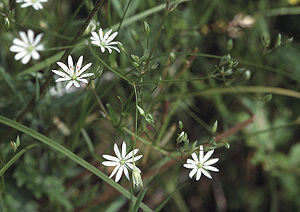Grass chickweed
| Grass chickweed | ||||||||||||
|---|---|---|---|---|---|---|---|---|---|---|---|---|

Chickweed ( Stellaria graminea ) |
||||||||||||
| Systematics | ||||||||||||
|
||||||||||||
| Scientific name | ||||||||||||
| Stellaria graminea | ||||||||||||
| L. |
The grass chickweed ( Stellaria graminea ), even grass chickweed , belongs to the family of the Pink family (Caryophyllaceae). It is similar to the great chickweed , but has narrower leaves and its petals, which are split almost to the base, are hardly longer than the sepals.
Appearance
The perennial herbaceous plant reaches a stature height of about 10 to 50, sometimes up to 80 centimeters and forms a loose lawn. The square, branched stem looks rather limp. The narrow leaves are linear-lanceolate, slightly ciliate at the base, but otherwise glabrous and grass-green in color. They are about four centimeters long and grow in pairs opposite to each other, perching, only ascending but soon falling on the stem.
The inflorescence is spread out and forked. The branches are often bent arched. The small flower rarely has a diameter of more than 12 millimeters and has three styles. The five three-veined sepals are ciliate and about 3 to 5 mm long. The white petals are two-columned almost to the base and as long as or slightly longer than the sepals. Flowering time is from May to July.
The green, elongated capsule fruit is slightly longer than the calyx. It opens up five-pronged and releases the reddish brown grooved seeds one to 1.2 millimeters in size.
The number of chromosomes is 2n = 26, 39 or 52.
Distribution and ecology
The chickweed grows in poor mountain meadows and poor pastures, on paths and in fields. They can also be found in nutrient-poor wet meadows and moors. It prefers moderately fresh, moderately nutrient-rich, low-lime, neutral-moderately acidic, humus-rich, predominantly sandy loam soil. It is an acidification indicator and a pioneer plant . It occurs in Central Europe mainly in poor Molinio-Arrhenatheretea societies or somewhat eutrophic Nardetalia and in mountain field weed societies.
Stellaria graminea occurs in the temperate latitudes of Europe and West and Central Asia up to an altitude of about 1,200 meters above sea level. in front. In the Allgäu Alps, it rises in the Tyrolean part at the southern foot of the Sefenspitze up to 1900 m above sea level.
It was introduced to North America by Europeans. All over Germany, especially in areas with little lime. it occurs frequently. The species is common and common in Austria and Switzerland.
The species occurs almost exclusively in larger, but rarely stock-forming groups. They are fertilized by self- pollination or by insect pollination , the seeds are spread further with the help of the wind. The deciduous, perennial stem plant sprouts again on the root stock after the winter break.
Illustrations
Sources and further information
Individual evidence
- ↑ Oskar Sebald : Guide through nature. Wild plants of Central Europe. ADAC Verlag, Munich 1989, ISBN 3-87003-352-5 , p. 79.
- ↑ a b Erich Oberdorfer : Plant-sociological excursion flora for Germany and neighboring areas . 8th edition, page 374. Stuttgart, Verlag Eugen Ulmer, 2001. ISBN 3-8001-3131-5
- ↑ Erhard Dörr, Wolfgang Lippert : Flora of the Allgäu and its surroundings. Volume 1, IHW, Eching 2001, ISBN 3-930167-50-6 , p. 494.
further reading
- Henning Haeupler , Thomas Muer: picture atlas of the fern and flowering plants of Germany (= the fern and flowering plants of Germany. Volume 2). Published by the Federal Agency for Nature Conservation. Ulmer, Stuttgart 2000, ISBN 3-8001-3364-4 .
- Wolfgang Adler, Karl Oswald, Raimund Fischer: Excursion flora of Austria. Ed .: Manfred A. Fischer . Ulmer, Stuttgart / Vienna 1994, ISBN 3-8001-3461-6 .
- August Binz , Christian Heitz: School and excursion flora for Switzerland , Schwabe & Co. AG, Basel, 1986, ISBN 3-7965-0832-4
- Erich Oberdorfer : Plant-sociological excursion flora , Ulmer Verlag, Stuttgart, 1990, ISBN 3-8001-3454-3
- Christian August Friedrich Garcke : Illustrierte Flora , 1972, Paul Parey publishing house, ISBN 3-489-68034-0
Web links
- Grass chickweed. In: FloraWeb.de.
- Distribution map for Germany. In: Floraweb .
- Stellaria graminea L. In: Info Flora , the national data and information center for Swiss flora . Retrieved October 8, 2015.
- Thomas Meyer: Data sheet with identification key and photos at Flora-de: Flora von Deutschland (old name of the website: Flowers in Swabia )
- Profile at Electronic Atlas of the Plants of British Columbia (eng.)
- Entry in Flora of North America (English).
- Area map at "Den virtuella floran" (Swedish)








